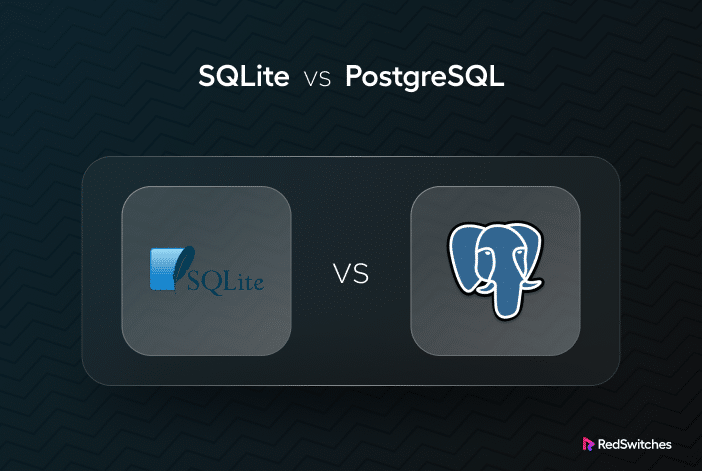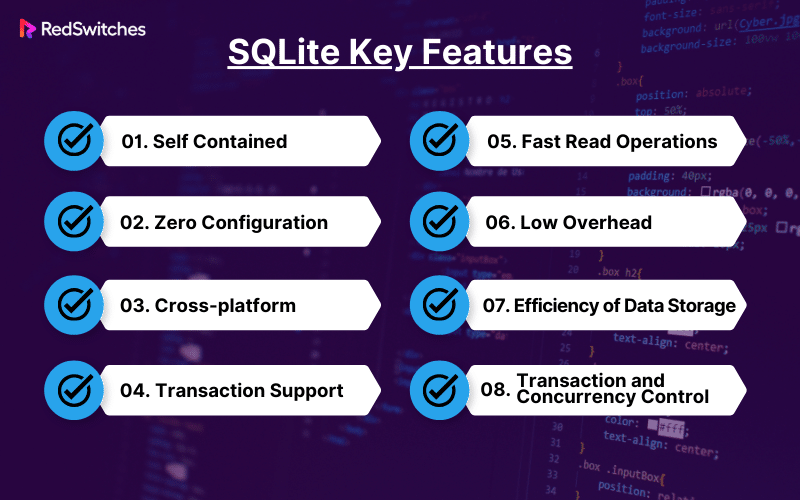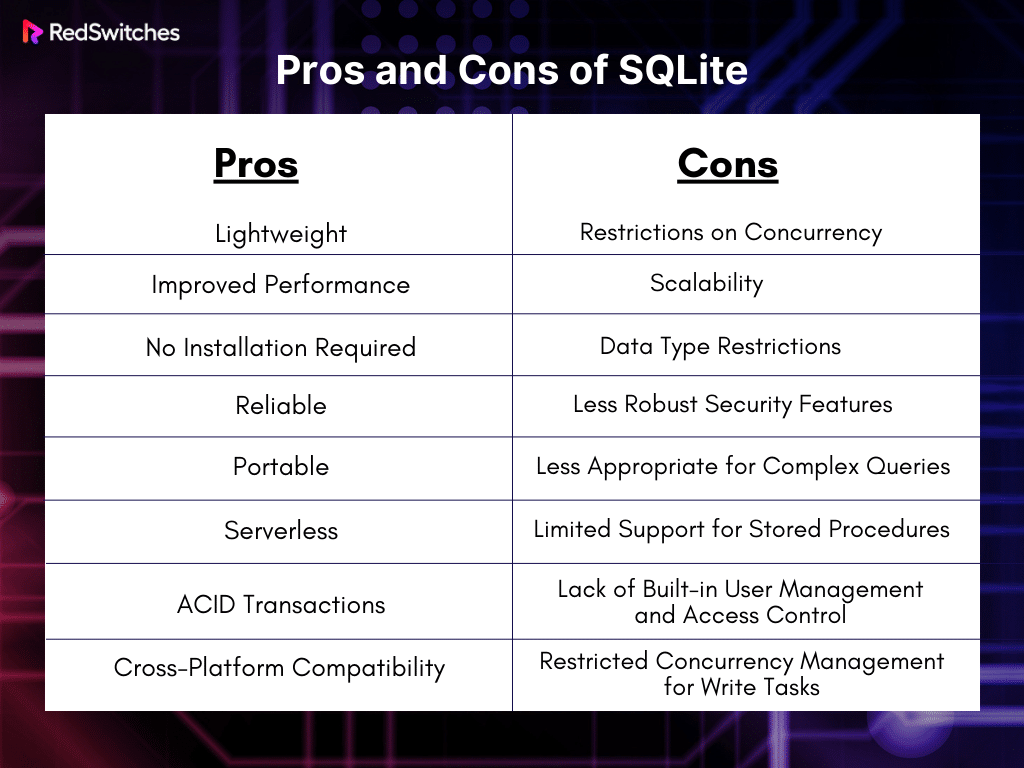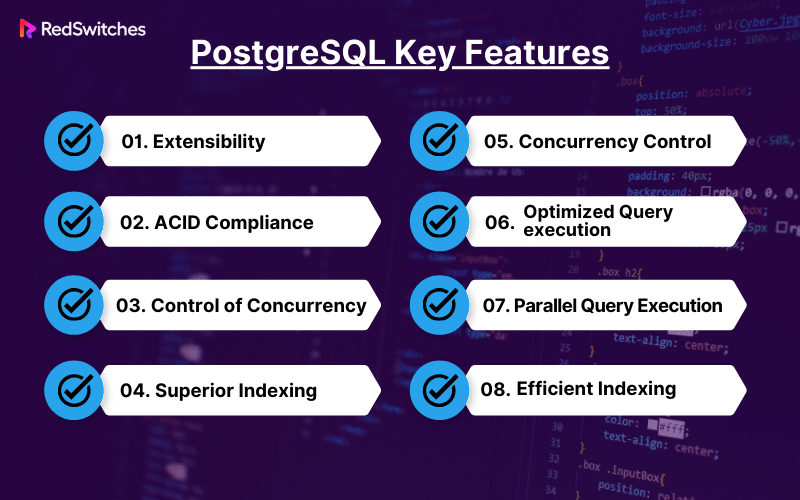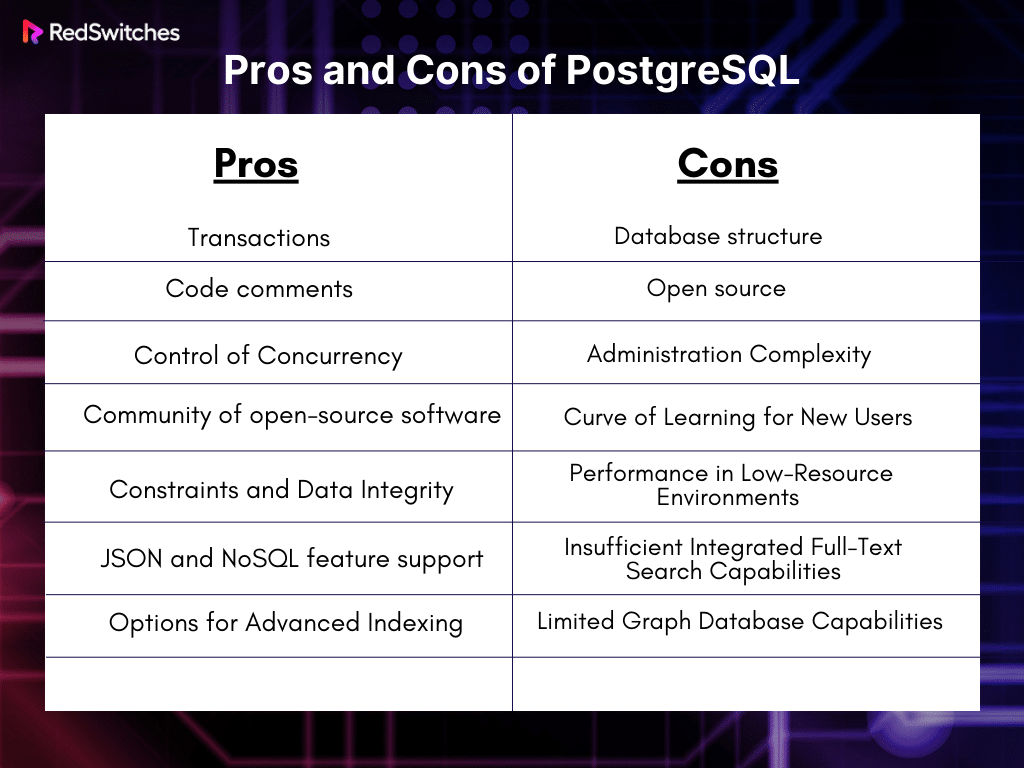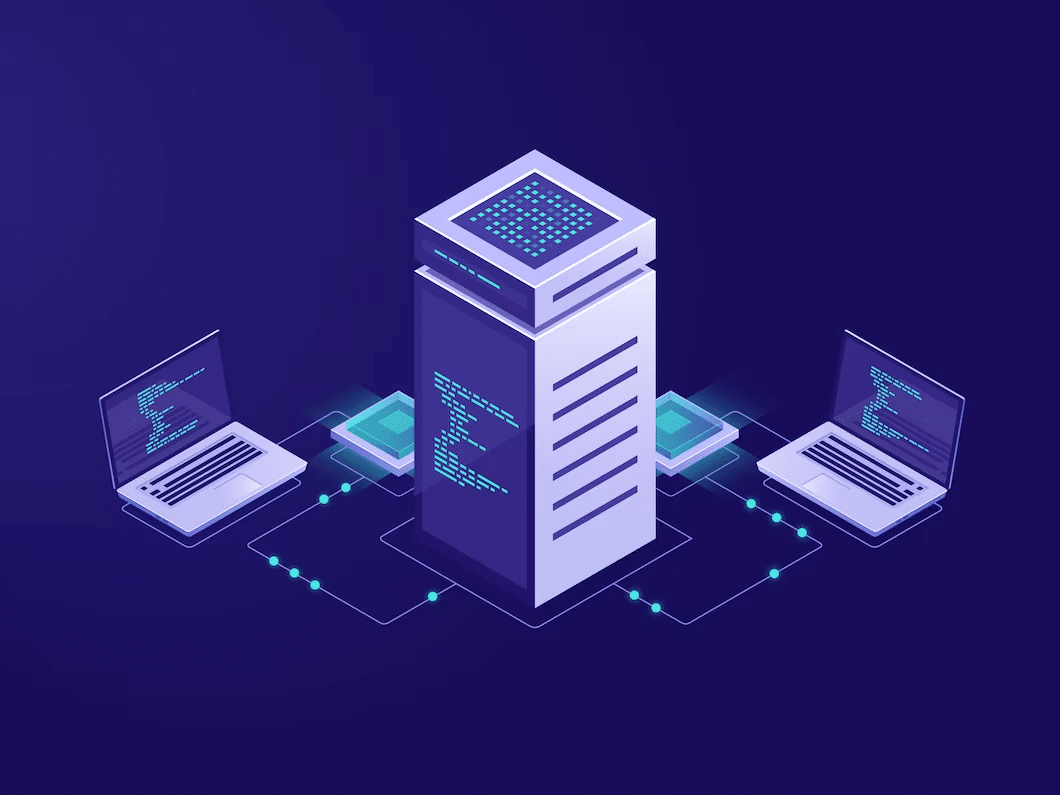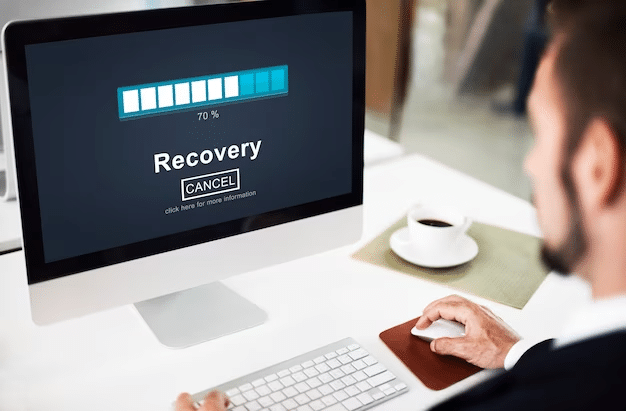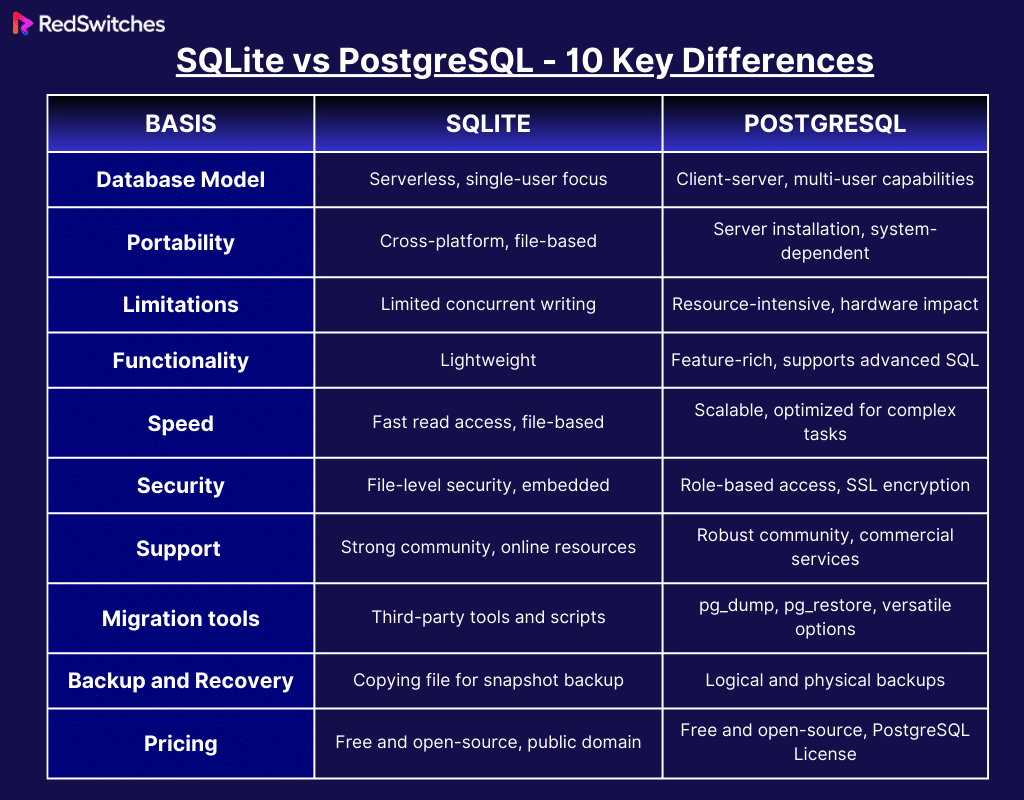Selecting the best database management system is essential for any tech enthusiast, developer, or business owner in the always-changing database management system market. The debate over the best databases is still alive and well in the digital community as we approach 2024.
Every database system has distinct advantages and disadvantages that allow it to meet the demands of various user groups and project specifications.
In this informative blog post, we will explain the ten main distinctions between PostgreSQL and SQLite, assisting you in navigating the complexity of two potent database options.
Table of Contents
- What is SQLite?
- What is PostgreSQL?
- PostgreSQL vs SQLite – 10 Key Differences
- SQLite vs PostgreSQL: Database Model
- SQLite vs PostgreSQL: Portability
- SQLite vs PostgreSQL: Limitation
- SQLite vs PostgreSQL: Functionality
- SQLite vs PostgreSQL: Speed
- SQLite vs PostgreSQL: Security
- SQLite vs PostgreSQL: Support
- SQLite vs PostgreSQL: Migration Tools
- SQLite vs PostgreSQL: Backup and Recovery
- SQLite vs PostgreSQL: Pricing
- When to Use SQLite?
- When to Use PostgreSQL?
- Conclusion
- FAQs
What is SQLite?
Credits: Pixabay
An embedded relational database management system without a server is called SQLite. It is an unrestricted, free library that runs entirely in memory and doesn’t need to be installed. It is also incredibly convenient because its size is less than 500 kb, a substantial reduction from other database management systems.
SQLite is a Database engine. It’s software that allows users to communicate with relational databases. One feature that sets SQLite apart from other database engines is the ability to store a database in a single file.
This feature makes databases extremely accessible: sharing a database can simply include sending an email attachment, and copying a database is no more complicated than copying the data file.
Key Features
Let us discuss the key features of SQLite.
Self Contained
SQLite does not require a separate server process to function, in contrast to client-server databases. The whole database is kept on a disc in a single file, making it simple to manage and transfer. Because of its simplicity, SQLite is a perfect option for applications and embedded systems requiring a small, local storage solution.
Zero Configuration
There isn’t much setup or administration needed for SQLite. No complicated configuration procedure or separate database server management is required. Developers looking for a simple and hassle-free method to include a database in their apps will find this ease of use especially helpful.
Cross-platform
Because of its cross-platform nature, SQLite is compatible with many operating systems, including Linux, macOS, Windows, and others. SQLite databases are more versatile because of their cross-platform interoperability, which makes it easy to transfer or deploy them across several systems without requiring any changes.
Transaction Support
Transactions are supported by SQLite, which makes it possible to combine several operations into a single process. Because transactions offer atomicity, consistency, isolation, and durability—also known as ACID properties—they guarantee the database’s integrity. This is important for applications, such as financial or critical systems, where data consistency is necessary.
Performance
When selecting a database system for their applications, developers should carefully consider SQLite’s performance. Many elements affect the engine’s performance characteristics, and each aspect substantially impacts the engine’s efficiency under varied conditions.
In the blog’s upcoming section, we will discuss performance in the SQLite vs PostgreSQL debate, where we will study SQLite vs Postgresql performance in detail.
Fast Read Operations
SQLLite excels at read-intensive activities. Because of its database design, data stored on discs may be accessed quickly, making retrieval exceptionally rapid.
Because of its B-tree indexing technique, which guarantees quick search and retrieval, it is perfect for applications where reporting and data querying are regular chores. SQLite’s read operations performance is a big plus for applications that need fast access to stored data.
Low Overhead
One of SQLite’s most notable characteristics is how little overhead it has. Because SQLite does not need a separate server process, it does not have the overhead associated with inter-process communication that comes with client-server database systems.
Efficiency of Data Storage and Retrieval
The data storage efficiency of SQLite is remarkable. To maximize storage capacity, it uses some strategies, including data compression and page-level storage. It is also appropriate for applications handling enormous amounts of data because of its efficiency in handling massive datasets.
SQLite’s indexing algorithms, such as B-trees and hash indexes, improve query speed when it comes to data retrieval by cutting down on the time needed for data lookup, which leads to quicker query response times.
Transaction and Concurrency Control
SQLite provides ACID transactions, guaranteeing Atomic, Consistent, Isolated, and Durable database operations. This ensures transaction and concurrency control. The reliability and consistency of the data depend on this transactional integrity.
However, SQLite has a single-writer design for concurrent write operations, meaning that only one process can write to the database simultaneously. Although this method guarantees data integrity, in highly concurrent environments—where numerous write operations co-occur—it may result in performance bottlenecks.
As a result, it uses less memory and CPU power because it runs directly on disc data. Because of its efficiency, it’s an excellent option for embedded systems, mobile apps, and situations with limited resources, where reducing overhead is essential for achieving peak performance.
Credits: Freepik
Pros and Cons of SQLite
Pros
Before discussing Postgre SQL, let’s have a look at the advantages and disadvantages of SQLite.
Lightweight
Because SQLite is a relatively light database, it is simple to use as embedded software with TVs, mobile phones, cameras, and other household electronics. Because of its small size and small memory footprint, it can operate well on devices with little processing and storage power, which makes it perfect for mobile devices, Internet of Things (IoT) devices, and other situations with limited resources.
The lightweight design improves the user experience across various applications by guaranteeing fast startup times and responsive performance.
Improved Performance
SQLite databases have extremely quick reading and writing speeds. Compared to the File system, it is over 35% faster.
It loads the required material instead of reading and storing the entire file in memory.
Modifications made in modest increments only overwrite the modified portions of the file.
High-performance data retrieval and manipulation are optimized with SQLite. Because its architecture handles read and write operations, it can be effectively used in applications where quick access to data is necessary.
SQLite’s little overhead, simplified storage structure, and sophisticated query optimization techniques allow for outstanding performance. It is the recommended option for applications where performance is crucial because of its design principles, which prioritize speed and responsiveness.
No Installation Required
Learning SQLite is quite simple. It doesn’t require installation or configuration. You only need to download the SQLite libraries to your PC to build databases.
The ease of use of SQLite is one of its main benefits. Unlike conventional database management systems, SQLite does not require a separate installation process. By integrating SQLite directly into their apps, users may do away with cumbersome setup processes and deployment headaches.
Because of how simple it is to integrate, developers can concentrate on application logic instead of handling complex database installations and configurations.
Reliable
It continuously refreshes your content, so in the event of a crash or power outage, little to no effort is lost.
Compared to specially created file I/O codes, SQLite is less prone to errors.
Because SQLite queries are more minor than corresponding procedural routines, problems are less likely.
SQLite is well known for its robustness and dependability. It is made to withstand a variety of errors, such as system crashes and power outages, without sacrificing the integrity of the data. The ACID (Atomicity, Consistency, Isolation, Durability) compliance of transactions is ensured by SQLite, resulting in predictable and dependable database operations.
Applications requiring a robust and secure data storage solution can rely on it because of its fault tolerance and crash-proof design.
Portable
SQLite is adaptable with both big- and little-endian architectures and all 32- and 64-bit operating systems.
The same application file can be associated with multiple processes, and they can all read and write without interfering with one another.
It is compatible with every programming language and may be used.
The mobility of SQLite is one of its best qualities. Because the entire database is kept in a single, cross-platform file, transferring, copying, and sharing it across other platforms and systems is simple.
Because of its portability, database management responsibilities are easier for developers. They can now construct apps that work flawlessly and require no alterations across various operating systems. The ease of transferability of SQLite databases allows for data mobility and flexibility in various settings.
Serverless
SQLite is a database engine that runs without needing a separate server process. This facilitates deployment and management by streamlining the setup and maintenance procedure.
SQLite functions in a serverless fashion, in contrast to client-server database systems. A separate database server process is unnecessary because SQLite libraries handle database access directly within the application.
This serverless architecture removes the complexity of setting up and maintaining a dedicated database server, making deployment and configuration easier.
Using SQLite, applications may be distributed without requiring a centralized server architecture, lowering costs and guaranteeing hassle-free distribution.
ACID Transactions
SQLite guarantees dependable database operations and data integrity even during failures by supporting ACID (Atomicity, Consistency, Isolation, Durability) transactions.
SQLite ensures transaction integrity by adhering to the ACID properties. Database transactions must be Atomic (indivisible and either fully executed or entirely rolled back), Isolated (unaffected by other transactions), Consistent (preserving data consistency and constraints), and Durable (persistently stored once committed) to comply with ACID compliance.
Because of SQLite’s transactional stability, applications can maintain data integrity and reliability even during unexpected events such as power outages or program crashes.
Cross-Platform Compatibility
The ease with which SQLite databases may be moved between various platforms and architectural styles makes data migration and sharing across several systems possible.
Cross-platform compatibility of SQLite is a big plus for developers making apps for different platforms and operating systems. SQLite guarantees smooth compatibility whether created for Windows, macOS, Linux, Android, iOS, or other operating systems.
With the ability to design applications that function consistently across platforms, developers can simplify the development process and reach a wider audience. Because SQLite works in a variety of contexts, developers may create apps that are flexible and accessible by allowing them to function on a wide range of devices and operating systems.
Cons
Now, we will discuss the opposing sides of SQLite.
Restrictions on Concurrency
SQLite’s architecture only permits one writer at a time. Multiple write operations occurring simultaneously in highly concurrent applications can cause performance bottlenecks and reduced responsiveness.
Scalability
Despite being great for small to medium-sized applications, SQLite may not scale well for large, high-traffic systems. Large datasets or high transaction rates are not well suited for it due to its file-based architecture and low concurrency.
Data Type Restrictions
Unlike certain other database systems, SQLite provides a more constrained selection of data types. While it covers the fundamental data types, developers may run into issues when working with complicated data models that call for specialized data structures or advanced data types.
Less Robust Security Features
SQLite might not be the best option for applications with strict security requirements, even though it does include some basic security methods like file-based encryption and user authentication. SQLite may lack more sophisticated security measures present in enterprise-level database systems.
Less Appropriate for Complex Queries
SQLite has more restricted query optimization capabilities than more expansive database management systems. Complex and resource-intensive queries may take longer to execute, even though it works fine for simple queries.
Applications primarily using intricate joins, subqueries, or aggregations may find that other database systems with more advanced query optimization features better suit their requirements.
Limited Support for Stored Procedures
Unlike certain other database systems, SQLite offers less support for triggers and stored procedures. Although it supports triggers, stored procedures—necessary for intricate database implementations of business logic—are not fully supported. When utilizing SQLite, applications that need sophisticated stored procedure functionality may encounter constraints.
Lack of Built-in User Management and Access Control
SQLite lacks built-in user management and access control capabilities, unlike certain database management systems. It does enable file-level security, but it can be difficult to build user-level fine-grained access control. Custom security measures may be necessary for applications that demand strong user authentication and access control features, which might complicate the development process.
Restricted Data Types
SQLite’s fundamental data types are text, floats, integers, and blobs. These address most everyday use cases, although they may not be sufficient for applications requiring complicated or specialized data types. Applications involving semi-structured formats may find it disadvantageous that native support for arrays and JSON data types is lacking.
Restricted Concurrency Management for Write Tasks
SQLite has limited concurrent writing operations but permits concurrent read operations. SQLite employs a file-level locking mechanism when numerous users or processes try to write to the database at the same time. In high-concurrency circumstances, this may result in reduced performance and contention problems.
Database systems with more sophisticated concurrency control algorithms, such as multi-version concurrency control (MVCC), may handle concurrent writes more effectively.
What is PostgreSQL?
Credits: wikimedia
Open source and very capable, PostgreSQL is an object-relational database system that builds upon the SQL language and incorporates numerous capabilities to store and handle even the most complex data demands securely. With almost 35 years of continuous development on the core platform, PostgreSQL began as a section of the POSTGRES project at the University of California in Berkeley in 1986.
Because of its well-established design, dependability, data integrity, extensive feature set, extensibility, and the commitment of the open-source community to continuously provide cutting-edge solutions, PostgreSQL has garnered a solid reputation.
PostgreSQL features substantial add-ons like the well-known PostGIS geospatial database extender and is compatible with all major operating systems. It has been ACID-compliant since 2001.
Key Features
Extensibility
Because of PostgreSQL’s great extensibility, users can define their functions, operators, indexing strategies, and data types. Its extensibility renders it a flexible platform capable of managing diverse data types and intricate use cases. To increase functionality, users can make extensions or use existing ones.
ACID Compliance
PostgreSQL guarantees data integrity and dependability by following the principles of ACID (Atomicity, Consistency, Isolation, Durability). Applications that need strong transaction support, such as financial systems, e-commerce platforms, and other mission-critical apps, must be in conformity with ACID standards.
Control of Concurrency
A multi-version concurrency control (MVCC) method in PostgreSQL enables many transactions to happen concurrently without interfering with one another. Because of this, the system can operate at higher speeds and scale more efficiently, all while preserving data consistency and concurrency. MVCC is very useful in settings where read and write demands are high.
Superior Indexing
Numerous indexing alternatives are available in PostgreSQL, such as B-tree, Hash, GIN (Generalised Inverted Index), GiST (Generalised Search Tree), and SP-GiST (Space-Partitioned Generalised Search Tree). These indexing techniques enable users to maximize database performance for certain use cases by accommodating various data types and query patterns.
Performance
PostgreSQL’s exceptional performance is one factor contributing to its widespread use. Here’s a closer look at the elements that go into its outstanding performance:
Concurrency Control
Multiple transactions can run concurrently in PostgreSQL thanks to MVCC (Multi-Version Concurrency Control), which prevents transactions from blocking one another. This system is appropriate for applications with significant transaction rates and complex data access patterns because it guarantees effective handling of concurrent read and write operations.
Query execution that is optimized
Postgres has a cost-based query optimizer that evaluates different query execution strategies and chooses the most effective one. Complex query response times are lowered by this clever optimization, which guarantees the most efficient execution of queries.
Parallel Query Execution
Multiple CPU cores can perform a query simultaneously, thanks to PostgreSQL’s capability for parallel query execution. This feature takes full advantage of the computing capability of contemporary multi-core computers to improve query performance for data-intensive operations.
Efficient Indexing
Postgres provides a variety of indexing methods, enabling programmers to design indexes customized for particular data kinds and query patterns. When adequately created and used, indexes improve query performance by reducing the time needed for data lookup—especially when dealing with massive datasets.
Pros and Cons of PostgreSQL
First, let’s discuss the advantages of PostgreSQL.
Pros
Transactions
If you don’t have any transactions, consider how many extra programs you’ll need to create to handle errors. Additionally, you will require transaction labels and end up with a client-side library if you must code that error handling every time you write a program. However, why even bother because you have a database that facilitates transactions? You may access transactional DDL using PostgreSQL.
This includes building tables, dropping tables, auto tables, and other operations in addition to your standard INSERT, UPDATE, and DELETE commands for the transaction. The way it operates differs significantly from Oracle’s.
Code comments
PostgreSQL gives you code comments, unlike other database programs. Before locking a piece of code for an application, code comments let you examine what the code does and does not do. This implies that you will be able to decipher the design and open and follow the engineering process.
As a result, we can increase community size, security, and quality because more people can participate and observe what’s happening with the code. Hence, rather than just being a lifeless piece of code on GitHub, the concept of a code comment leads to a fully operational open-source community.
Control of Concurrency
Multi-version concurrency Control (MVCC) is a technique PostgreSQL uses to manage concurrent transactions effectively. In high-concurrency contexts, this guarantees that numerous transactions can happen concurrently without interfering, improving the system’s performance and scalability.
A vibrant community of open-source software
One of the advantages of PostgreSQL is its dynamic and active open-source community. This community improves the overall quality of the database system, offers help, and contributes to continuous growth. The community’s collaborative spirit encourages innovation and ongoing development.
Constraints and Data Integrity
A wide range of constraints, such as PRIMARY KEY, FOREIGN KEY, UNIQUE, CHECK, and NOT NULL constraints, are supported by PostgreSQL. By avoiding errors and inconsistencies in the recorded data, these constraints aid in enforcing data integrity at the database level.
JSON and NoSQL feature support
Users can store and query JSON documents using PostgreSQL’s native support for JSON data. Applications working with semi-structured data will find this helpful capability. Furthermore, the hstore extension for PostgreSQL offers a key-value storage solution that enables NoSQL-like features in relational database environments.
Options for Advanced Indexing
Numerous indexing alternatives are available in PostgreSQL, such as B-tree, Hash, GiST, GIN, and SP-GiST. These indexing techniques enable users to maximize database performance for specific use cases by accommodating various data types and query patterns.
Cons
Database structure
A relational database is the standard used for a database in Postgres. This indicates that our database operates under certain presumptions or in a particular manner. And is the SQ language that you employ naturally?
Tables in this type of database function similarly to a data bin or storage container. Therefore, there are very strict criteria for the data we save in our database tables while querying data with SQL. A well-defined schema defines fields and specifies what data can be entered into a table.
Open source
Since Postgres is an open-source database program, it is not possessed by a single company. It struggled to gain recognition compared to the proprietary software, which possesses complete control and copyright over the product, even if it was packed with features and had exceptional capabilities. As such, it is unsupported by a warranty and offers neither liability nor indemnity protection.
Administration Complexity
Compared to more straightforward, serverless databases like SQLite, managing and administering a PostgreSQL database might be more complicated. Particularly in big and enterprise-level deployments, the requirement for configuration, optimization, and maintenance chores may necessitate a greater level of knowledge.
Curve of Learning for New Users
New users may find the learning curve higher with PostgreSQL due to its complex capabilities and extensibility, primarily if they are used to simpler databases. Knowing and utilizing PostgreSQL’s full potential could require time and more training.
The Effect of Performance in Low-Resource Environments
The amount of resources that PostgreSQL uses could affect performance in settings when hardware resources are few. Compared to lighter database systems, it may not be as effective in low-resource conditions, even though it performs exceptionally well in scalability and high-concurrency scenarios.
Insufficient Integrated Full-Text Search Capabilities
Although PostgreSQL has full-text search capabilities, some users discover that specialized full-text search engines like Elasticsearch may perform better than PostgreSQL in some search-intensive applications. This restriction may impact applications with high search requirements.
Limited Graph Database Capabilities
While PostgreSQL supports complex data types and extensibility, it may not be optimal for applications heavily focused on graph-based data structures. Dedicated graph databases might provide more efficient solutions for scenarios requiring extensive graph database capabilities.
PostgreSQL vs SQLite – 10 Key Differences
Credits: Freepik
Now, we will come to the core part of our blog,i.e. 10 critical differences between SQLite and PostgreSQL, in detail. Let’s kick start.
SQLite vs PostgreSQL: Database Model
The first key difference in the SQLite vs postgresql argument is comparing their Database model. Let’s understand.
SQLite
With its serverless architecture, SQLite may work as a stand-alone library without requiring its server process because its design works exceptionally well with embedded systems and situations where a small, local database suffices. Although it can manage many connections, SQLite is designed with single-user access in mind, and write operations are serialized.
The management and dissemination of SQLite databases are made more accessible because they are all kept on disc in a single file. However, in contexts with high transaction volumes, this file-based storage could have issues with scalability and performance.
PostgreSQL
The client-server architecture used by PostgreSQL allows the database server to handle numerous concurrent client connections. Because of its architecture, PostgreSQL can be used in applications requiring many users and high levels of concurrent access.
PostgreSQL is made explicitly for multi-user access, unlike SQLite, which enables multiple users to connect and interact with the database simultaneously. It uses an advanced locking system to control concurrent access and guarantee data consistency.
SQLite vs PostgreSQL: Portability
Portability is another crucial differential factor in the SQLite vs postgresql debate.
SQLite
SQLite is a serverless, zero-configuration, self-contained database engine frequently used as an embedded database in applications. Since the databases are just single standard disc files, transferring the database file from one system to another is simple. Because of SQLite’s cross-platform interoperability, databases generated on one operating system can be utilized without any changes on another.
PostgreSQL
Due to PostgreSQL’s client-server architecture, a PostgreSQL server installation is required on all systems that will use the database. Because PostgreSQL databases depend on servers, moving them between systems can be more complicated than moving SQLite databases. Portability may be impacted by the setup procedure and any operating system variations, particularly when transferring data across several environments.
SQLite vs PostgreSQL: Limitation
In the long-lasting SQlite vs postgresql debate, which one has more limitations? Let’s understand.
SQLite
SQLite has several drawbacks despite being very portable and appropriate for embedded applications. Its concurrent writing performance is severely limited since it uses a file-locking approach that can cause contention in situations with a lot of writing activity. Additionally, because its architecture puts simplicity ahead of sophisticated capabilities, SQLite might not be the most excellent option for large-scale applications or those requiring complicated transactions.
PostgreSQL
Despite being a robust and feature-rich database system, PostgreSQL has several drawbacks. One thing to remember is how much resource it uses, particularly when compared to lightweight databases like SQLite. PostgreSQL may use more system resources, and its performance may suffer in settings with low hardware resources.
SQLite vs PostgreSQL: Functionality
Functionality is another critical factor in the SQLite vs PostgreSQL debate.
SQLite
Its capability fits particularly well with mobile applications, embedded devices, and situations where a simple solution is adequate. While SQLite allows you to access and manipulate data using the standard SQL language, it does not have all of the sophisticated features in larger database management systems.
PostgreSQL
Robust and open-source, PostgreSQL is a relational database management system with many capabilities that may be used for many purposes. Because it supports advanced SQL features like triggers, stored procedures, and multiple indexing strategies, it is ideal for intricate data models and sophisticated business logic.
SQLite vs PostgreSQL: Speed
Speed and performance are arguably the most critical points in the SQLite vs PostgreSQL debate.
SQLite
SQLite is well known for its speed and effectiveness, especially when ease of use and a small footprint are critical. Its file-based storage and serverless design facilitate speedy read access, which makes it ideal for small- to medium-sized projects, mobile applications, and embedded systems.
However, because of its file-level locking method, SQLite’s performance may suffer in high-concurrency write scenarios, affecting its competitiveness in large write loads or complicated transactions.
PostgreSQL
PostgreSQL’s design prioritizes scalability and performance, making it ideal for situations requiring the effective management of complex transactions and high concurrency. The Multi-Version Concurrency Control (MVCC) mechanism improves read and write activities by permitting concurrent transactions without causing a block.
PostgreSQL’s client-server architecture and optimization capabilities make it popular for applications with strict performance needs and larger datasets. Its features include parallel query execution and many indexing algorithms.
SQLite vs PostgreSQL: Security
Credits: Freepik
There are some essential elements in which organizations will never compromise, including Security.
Let’s discuss which relational database triumphs in the SQLite vs PostgreSQL debate.
SQLite
Unlike client-server databases like PostgreSQL, SQLite, a serverless and self-contained database engine, offers a different security paradigm. Usually, SQLite databases are protected at the file system level, depending on the access controls of the underlying operating system. This indicates that a key security component is access to the database file itself.
Ensuring appropriate file permissions and encryption for the SQLite database file may be the main security problem in embedded settings or local applications where SQLite is frequently used.
PostgreSQL
The client-server database system PostgreSQL provides a robust security model, including features like role-based access control, user authentication, and SSL encryption for data transport.
It permits the establishment of user roles with particular rights, providing more precise control over database access. Additionally, PostgreSQL offers secure connection options, such as encrypting data as it is transmitted between the client and the server using SSL certificates.
SQLite vs PostgreSQL: Support
SQLite
Because of its well-known simplicity and ease of use, SQLite is frequently used for projects where an embedded, lightweight database will suffice. Compared to larger database systems, SQLite may have fewer formal support alternatives while having a robust user community and a wealth of online documentation. Usually, email lists, online manuals, and community forums serve as SQLite’s main support avenues.
PostgreSQL
A strong and vibrant open-source community that offers a wealth of online documentation and discussion boards supports PostgreSQL. Commercial organizations and vendors provide expert PostgreSQL support services and community support. Training, consulting, and technical assistance are a few examples of these services.
SQLite vs PostgreSQL: Migration Tools
SQLite
Because SQLite is lightweight and self-contained, the database system does not have built-in migration tools. However, third-party tools, unique scripts, or manual procedures can be used to migrate data from SQLite to another database or vice versa.
To aid in the migration process, developers frequently utilize tools like the SQLite Export tool, scripting languages like Python, and libraries like SQLAlchemy.
PostgreSQL
Many tools and utilities are available in PostgreSQL to help in data migration into and out of the database. For example, PostgreSQL databases are frequently backed up and restored using the pg_dump and pg_restore command-line tools. These tools offer a range of options for managing data and adjusting the output format throughout the transfer process.
SQLite vs PostgreSQL: Backup and Recovery
Credits: Freepik
One of the essential differences between SQLite and postgresql is Backup and Recovery.
SQLite
Because SQLite is a file-based, serverless database, backup and recovery are done simply. Making a copy of the SQLite file, which provides a snapshot of the whole database at a particular moment, is backing up a SQLite database. The file can be copied manually, or backup alternatives are available using tools like the SQLite3 command-line application.
If a backup copy is available, it can replace the active database file in case of recovery. However, point-in-time recovery to a particular transaction is not directly supported by SQLite due to its lack of built-in support for transaction logs.
PostgreSQL
Compared to SQLite, PostgreSQL offers more sophisticated backup and recovery options. Logical backups are often created using the pg_dump and physical backups using pg_basebackup, respectively. Point-in-time recovery is made possible by these tools, which enable the creation of consistent backups of PostgreSQL databases that include transaction logs.
PostgreSQL’s Write-Ahead Logging (WAL) feature logs database changes and enables accurate recovery to any point in the log. This feature is essential to minimizing data loss and guaranteeing data consistency.
SQLite vs PostgreSQL: Pricing
In the crucial debate of SQLite vs PostgreSQL, Pricing plays a key aspect in an organization’s budgetary plans.
SQLite
SQLite is available in the public domain and is free and open-source software. It is licensed under a permissive (public domain), which permits unrestricted use, modification, and distribution without needing payment or fees. Because of this, SQLite is a desirable option for projects that have limited funding or that give priority to free solutions.
SQLite’s cost-effectiveness is significant in its widespread acceptance in embedded devices, mobile applications, and small-to-medium-sized projects.
PostgreSQL
Like the MIT Licence, PostgreSQL is similarly free and open-source software distributed under the PostgreSQL Licence. Like SQLite, PostgreSQL has no licensing costs and is freely used, changed, and distributed. It’s crucial to remember that although PostgreSQL software is free, additional expenses for services from commercial providers or third-party vendors and support and consultancy can be added.
While commercial support services might be expensive for organizations, the fundamental PostgreSQL database technology is still free and open-source.
When to Use SQLite?
So, the all-important question that arises is when to use SQLite.
Embedded applications: SQLite is an excellent tool for small-scale data storage on devices like air conditioners, fitness trackers, and phones.
Low-traffic website: SQLite is an excellent option for modest operations but is not the greatest choice for large volumes of data or users due to its lack of setup and configuration needs.
Testing: An excellent low-tech substitute for quick testing that doesn’t require setting up a real database.
Quick development and prototyping: It’s a valuable option when you need to quickly implement a database without the hassle of complicated configurations because of its lightweight design and ease of integration. This is especially helpful in the early phases of developing an application when the main priority is developing and perfecting core functionalities.
Desktop programs for One User: When numerous users cannot concurrently access the database, SQLite is a suitable option for desktop programs for one user. SQLite’s efficiency and simplicity make it ideal for note-taking apps, personal budget managers, and small-scale desktop tools without requiring a separate database server.
When to Use PostgreSQL?
PostgreSQL is the apparent choice for complicated tasks because of its capability for numerous concurrent writers and query strategies utilizing multiple CPUs.
When customization is needed: have significantly more freedom over MySQL database configuration regarding extensive customizability.
Data Warehousing: PostgreSQL is ideal for data analysis applications because of its rapid read/write performance.
Complex Data Types and Extensibility: PostgreSQL is well known for supporting extensibility and sophisticated data types.
Geospatial Data and GIS Applications: PostgreSQL is a good option if your application handles bespoke data types and sophisticated data structures or if you need to design your operators, functions, or aggregates. Because of its flexibility, developers can customize the database to meet unique demands, making it appropriate for complex data modeling projects.
Conclusion
Finally, the comparison of SQLite vs PostgreSQL has highlighted the advantages and disadvantages of both widely used database management systems. Because of its ease of use and low configuration requirements, SQLite is the perfect choice for smaller projects and apps. Simple desktop programs and mobile apps can benefit from its self-contained design and ease of usage.
Conversely, PostgreSQL can handle complicated and demanding environments thanks to its extensibility, scalability, and rich feature set. Large-scale applications, data warehousing, and analytical processing choose it because it supports sophisticated data types, strong indexing, and concurrent access. PostgreSQL thrives in performance under high workloads and diversity, while SQLite excels in simplicity.
RedSwitches knows how critical it is to choose the best database solution for your company’s requirements. Whether you choose PostgreSQL’s strength or SQLite’s simplicity, our committed team of professionals can offer customized hosting solutions to guarantee your database operates at peak efficiency, supported by our dependable infrastructure and first-rate support services.
FAQs
Q. Is SQLite the same as PostgreSQL?
No, PostgreSQL and SQLite are separate database management systems with unique capabilities and applications.
Q. SQLite vs PostgreSQL: Which one is better?
Although PostgreSQL is an advanced open-source relational database management system that uses SQL for data manipulation and querying, it is not inherently superior to SQL
Q. Does PostgreSQL use SQLite?
No, PostgreSQL and SQLite are two distinct database management systems, each having a remarkable architecture and set of features.
Q. What is the difference between SQLite and PostgreSQL?
SQLite is a lightweight, serverless, and self-contained database management system, while PostgreSQL is a sophisticated, open-source, object-relational database management system.
Q. When should I use SQLite over PostgreSQL?
SQLite may be a better choice for applications that require a smaller memory footprint, are embedded, or need a serverless architecture.
Q. In what scenarios should I opt for PostgreSQL instead of SQLite?
PostgreSQL may be a better fit for applications that require more advanced features, scalability, concurrency, or a client-server model.
Q. Can SQLite handle large-scale applications and complex queries?
While SQLite is capable of handling large datasets and complex queries, it may not be as suitable as PostgreSQL for scenarios with high concurrency and extensive write operations.
Q. What are some key differences in the use cases for SQLite and PostgreSQL?
SQLite is commonly used in embedded systems, mobile apps, and local storage, while PostgreSQL is preferred for web applications, client-server architectures, and enterprise-level databases.
Q. How does the performance of SQLite compare to PostgreSQL?
In general, SQLite is known for its simplicity and lightweight nature, whereas PostgreSQL is recognized for its robustness, scalability, and advanced optimization features that make it more suitable for high-performance applications and complex workloads.
Q. Can both SQLite and PostgreSQL work with SQL databases?
Yes, both SQLite and PostgreSQL are fully SQL-compliant databases and support the SQL standard for creating, querying, and managing databases.
Q. What are some of the key data types supported by SQLite and PostgreSQL?
Both SQLite and PostgreSQL support a wide range of data types, including integers, text, floating-point numbers, dates, and more, in accordance with the relational model.
Q. What are the main differences between SQLite and PostgreSQL in terms of architecture and operation?
One major distinction is that SQLite is an embedded database management system, while PostgreSQL operates as a client-server model, providing multi-user access and advanced server-side functionality.
Q. Could you explain the performance comparison between using PostgreSQL and SQLite for specific use cases?
When choosing between PostgreSQL and SQLite, it’s important to consider the specific use case and performance requirements, as PostgreSQL’s server architecture and advanced optimization can offer higher performance, particularly for applications with complex data manipulation and high concurrency.
